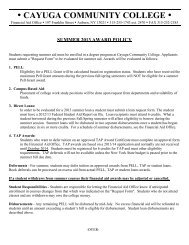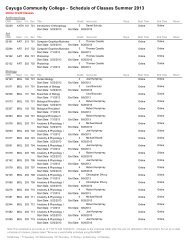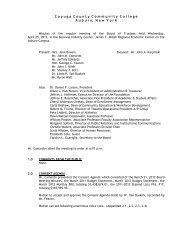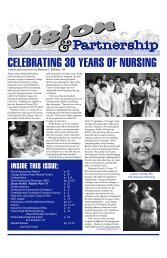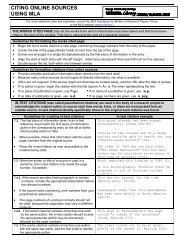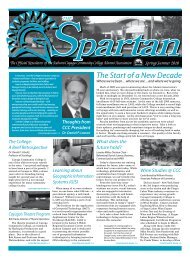THE CRITICAL LITERARY ESSAY - Cayuga Community College
THE CRITICAL LITERARY ESSAY - Cayuga Community College
THE CRITICAL LITERARY ESSAY - Cayuga Community College
Create successful ePaper yourself
Turn your PDF publications into a flip-book with our unique Google optimized e-Paper software.
A strong thesis, on the other hand, shows a depth of understanding of the work in question. It<br />
speaks of things not merely resting on the surface of the stories. It requires original thought, and<br />
it makes clear, focused statements about what the essay will discuss. Remember: A strong thesis<br />
is not merely a rewording of an assigned topic.<br />
Examples of strong theses:<br />
Although Bartelby and the Underground Man are both alienated from their society, they<br />
suffer their alienation in radically different ways: Bartelby gradually withdraws from all<br />
human contact in an attempt to fade into the background of life, while the Underground<br />
Man rages against the world because he feels he has already faded out of existence.<br />
“The Dead” is Joyce’s metaphor for the lifeless gaiety of Dublin society, the<br />
hopelessness of lost love, and the brutality of passing time.<br />
See the difference.<br />
Primary and secondary sources<br />
A primary source is the work at the center of your topic and thesis. Secondary sources are works<br />
by one author about another author’s works. For example, if you are writing about Kafka’s The<br />
Metamorphosis, then The Metamorphosis is your primary source. Vladimir Nabokov’s lectures<br />
on The Metamorphosis are a secondary source for The Metamorphosis.<br />
Points to consider in using primary and secondary sources:<br />
If you are reading a primary source in translation, and there is more than one version or<br />
translation, you’ll have to make a decision on which version is best. This can be difficult to<br />
do if you don’t speak or read the language of the original. In that case you’ll have to find<br />
what scholars think about the competing translations, and base your judgment on that<br />
information. Otherwise, any primary source is as good as the next, as long as the text is<br />
complete.<br />
Secondary sources are trickier. You have to judge which sources are more scholarly, more<br />
serious. This can be difficult if you are not well acquainted with the field. In that case, you<br />
should consult your instructor. You can also check the Works Cited pages of the books and<br />
articles you are considering for inclusion in your paper. If certain authors and works turn up<br />
in these lists again and again, then they are probably worth looking at.<br />
Finding primary and secondary sources: One way to find these sources is to search a library’s<br />
catalog. A search under the author’s name heading should yield primary sources. A search<br />
using the author’s name under the subject heading should yield secondary sources.<br />
In addition, as previously mentioned, you should also look at the Works Cited pages of books<br />
and articles you read; those are a great source for leads.<br />
Developing a literary thesis<br />
Developing a literary thesis in-depth in an essay is difficult. In order to write a thoughtful and<br />
interesting literary essay, you must immerse yourself in the subject. Although there are no hardand-fast<br />
rules that will assure you of writing a good literary essay, the following steps are good<br />
guidelines to follow:<br />
1. Read the primary source(s) more than once. The second time through, take notes on the<br />
work(s).<br />
2. Do not focus on the paper you must write. Instead, concentrate on the work you are reading.<br />
Ask yourself questions like: How does this story make me feel? Do I feel one way in one part<br />
and a different way in another? Why do I feel like this? Remember, literature, especially<br />
great literature, should not be read merely with the mind, but with the emotions as well.<br />
3. The second time you read the primary source, gear your reading toward those elements of the<br />
work that deal with your thesis. Do the same with your secondary sources.



